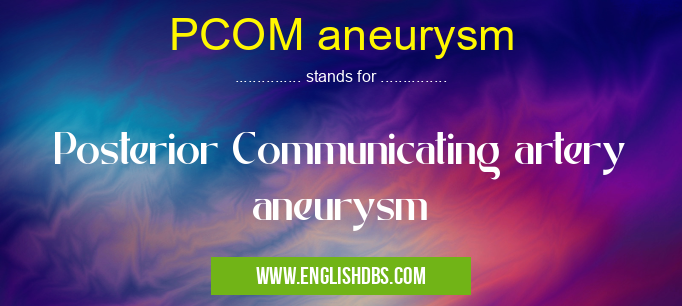What does PCOM ANEURYSM mean in THERAPY
A posterior communicating artery (PCOM) aneurysm is a type of cerebral aneurysm that occurs at the junction of the posterior communicating artery and the internal carotid artery. It is a relatively common type of aneurysm, accounting for approximately 20-25% of all intracranial aneurysms.

PCOM aneurysm meaning in Therapy in Medical
PCOM aneurysm mostly used in an acronym Therapy in Category Medical that means Posterior Communicating artery aneurysm
Shorthand: PCOM aneurysm,
Full Form: Posterior Communicating artery aneurysm
For more information of "Posterior Communicating artery aneurysm", see the section below.
Causes
The exact cause of PCOM aneurysms is unknown, but several risk factors have been identified, including:
- Hypertension: High blood pressure is the most significant risk factor for PCOM aneurysms.
- Smoking: Smoking damages the blood vessel walls, increasing the risk of aneurysm formation.
- Family history: Having a family history of aneurysms increases the risk of developing one.
- Age: PCOM aneurysms are more common in people over the age of 50.
- Connective tissue disorders: Certain connective tissue disorders, such as Marfan syndrome and Ehlers-Danlos syndrome, can weaken blood vessel walls and increase the risk of aneurysms.
Symptoms
Most PCOM aneurysms are asymptomatic, meaning they do not cause any symptoms. However, if an aneurysm ruptures, it can lead to a subarachnoid hemorrhage (SAH), which can cause:
- Sudden, severe headache
- Nausea and vomiting
- Stiff neck
- Sensitivity to light
- Seizures
- Loss of consciousness
Diagnosis
PCOM aneurysms are typically diagnosed through imaging tests, such as:
- CT scan: A CT scan uses X-rays to create detailed images of the brain and blood vessels.
- Magnetic resonance angiography (MRA): An MRA uses magnetic resonance imaging (MRI) to create images of the blood vessels in the brain.
- Cerebral angiography: Cerebral angiography involves injecting a dye into the arteries of the brain and taking X-rays to visualize the blood flow.
Treatment
The treatment for a PCOM aneurysm depends on its size, location, and the patient's overall health. Options include:
- Observation: Small, unruptured aneurysms may be monitored with regular imaging tests to check for growth or rupture.
- Endovascular coiling: A minimally invasive procedure that involves inserting a catheter into the aneurysm and filling it with coils to block blood flow.
- Surgical clipping: A surgical procedure that involves placing a clip around the neck of the aneurysm to prevent blood flow into it.
Essential Questions and Answers on Posterior Communicating artery aneurysm in "MEDICAL»THERAPY"
What is a posterior communicating artery (PCOM) aneurysm?
A PCOM aneurysm is a ballooning or bulging of a small artery that branches off the internal carotid artery and supplies blood to the brain. It is located near the base of the brain and can cause serious complications if it ruptures.
What are the symptoms of a PCOM aneurysm?
Most PCOM aneurysms do not cause any symptoms until they rupture. However, some people may experience:
- Headaches
- Nausea
- Vomiting
- Blurred vision
- Double vision
- Weakness or numbness on one side of the body
- Difficulty speaking or understanding speech
What causes a PCOM aneurysm?
The exact cause of PCOM aneurysms is unknown, but certain factors can increase the risk, including:
- High blood pressure
- Smoking
- Family history of aneurysms
- Certain genetic conditions
- Head injuries
How is a PCOM aneurysm diagnosed?
PCOM aneurysms are typically diagnosed using imaging tests, such as:
- Computed tomography (CT) scan
- Magnetic resonance imaging (MRI) scan
- Cerebral angiography
How is a PCOM aneurysm treated?
The treatment for a PCOM aneurysm depends on its size, location, and condition. Treatment options include:
- Observation: Small aneurysms that are not causing symptoms may be monitored without treatment.
- Endovascular coiling: A thin wire with a metal coil is inserted into the aneurysm to block blood flow and reduce the risk of rupture.
- Surgical clipping: A small metal clip is placed at the base of the aneurysm to prevent blood from entering it.
Final Words: PCOM aneurysms are a common type of cerebral aneurysm. While most are asymptomatic, a ruptured aneurysm can lead to a subarachnoid hemorrhage, which can be life-threatening. Diagnosis and treatment options depend on the size, location, and the patient's overall health. Early detection and treatment can significantly reduce the risk of complications.
PCOM aneurysm also stands for: |
|
| All stands for PCOM aneurysm |
